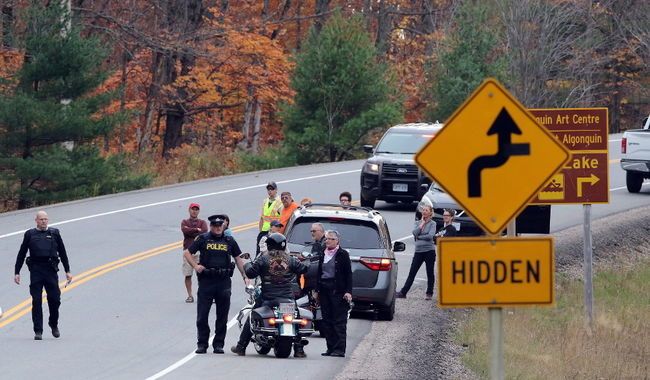
Pete Fisher Photography
Killaloe OPP officers work at the scene of a motorcycle crash Saturday, Oct. 21, 2017 in Algonquin Park. A Barrie motorcyclist died in the crash.
The 47 fatalities in the province so far this year is the highest number in more than a decade, OPP Highway Safety Division Sgt. Kerry Schmidt said Monday. A total of 258 people have been killed on OPP-patrolled roads.
Locally, there have been a total of nine fatal vehicle collisions so far this year, in which six motorcycle riders were killed, Peterborough County OPP media relations officer Const. Jason Folz said. That includes three people killed in a crash on County Road 507 north of Buckhorn on Aug. 20.
The figure does not include, however, the many riders who suffered life-altering injuries as a result of motor vehicle collisions, he noted.
Schmidt tweeted that more than half of motorcycle riders were driving properly at the time of the collisions that claimed 47 lives.
“It seems to be pretty consistent that the blame is shared equally,” Folz said.
Police can’t say if there have been more motorcycles on the road, or explain why rider fatalities have spiked, but what they do know is that the reasons for crashes – no matter what vehicles are involved – remain the same.
The “big three” – impaired, aggressive and distracted driving – continue to be the leading causes of all collisions, Folz said. The fourth factor, to round out the “big four,” is seatbelt compliance, which doesn’t apply to motorcyclists.
When it comes to aggression – many motorists are familiar with those who pass other vehicles in a line of traffic, often narrowly missing traffic heading in the other direction.
It’s unfortunate that drivers feel the need to be in front of the pack to gain a couple of seconds when in reality, it would be far safer to go with the flow, Folz pointed out.
That kind of driving, which is commonly seen during high-volume periods during long weekends, has played a role in several local crashes. “If you feel you need to pass two or three cars at a time, then it’s time to re-evaluate your driving.”
To do their part to reduce the risk, all motorists must share the road and keep a watchful eye – particularly at intersections and stop signs, the officer explained.
Motorcycle riders are encouraged to give themselves more lead time and to reduce their speed so they can react to situations as they unfold, Folz said. They can also wear bright-coloured gear to make them more visible to other drivers.
A rider himself, Folz pointed out that new motorcyclists also can’t just start driving the machines without proper training.
To see a list of government-approved motorcycle safety courses, visit www.mto.gov.on.ca/english/driver/motorcycle-safety-courses.shtml
NOTES: For more information on motorcycle safety, visit https://oppweb.sgc.gov.on.ca/opp/livefiles/news/motorcycle-safety-pamphlet.pdf, www.mmic.ca/ or https://www.ridertraining.org/.
Safety tips
Because motorcycle riders are more vulnerable and tougher to see, Central Region OPP offered this list of safety tips:
- Motorcyclists should not assume that other drivers can see them – drivers that have collided with motorcycles often say they did not see the motorcycle until it was too late.
- Always ride at a speed appropriate for road and weather conditions as speeding and loss of control are major causes of motorcycle collisions.
- When riding, always wear an approved motorcycle helmet and bright, high-quality protective gear to make yourself more visible to other motorists.
- Never take your focus away from operating the motorcycle, being on two wheels at highway speeds means that any loose gravel, uneven pavement or potholes will cause some sort of reaction from the handling of the bike and could cause you to lose control.
- Avoid riding in a vehicle’s blind spot as this can greatly reduce the chance of a potential collision caused by a motorist who may not see them.
Source: The Peterborough Examiner
